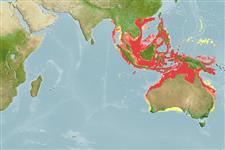Common names from other countries
Issue
Distribution needs major revision due to questionable (unconfirmed) occurences reported by major references (Ref. 57869:385-6).
Environment: milieu / climate zone / depth range / distribution range
Sinh thái học
Biển Cùng sống ở rạn san hô; sống cả ở nước ngọt và nuớc mặn (Ref. 51243); Mức độ sâu 1 - 350 m (Ref. 38189). Subtropical; 45°N - 44°S, 89°E - 154°E
Eastern Indian Ocean, Malay Peninsula, southern Philippines, northern Java, Arafura Sea, Louisiade Archipelago, and northern half and southwestern Australia. Reports of Introduction in the Mediterranean are questionable. Confirmed and questionable reports of its occurrence (and references) are discussed in Inoue & Nakabo 2006 (Ref. 57869:385-6).
Length at first maturity / Bộ gần gũi / Khối lượng (Trọng lượng) / Age
Maturity: Lm 19.8 range ? - ? cm
Max length : 50.0 cm SL con đực/không giới tính; (Ref. 3397); common length : 30.0 cm TL con đực/không giới tính; (Ref. 5450); Tuổi cực đại được báo cáo: 7 các năm (Ref. 94612)
Các tia vây lưng cứng (tổng cộng) : 0; Các vây lưng mềm (tổng cộng) : 11 - 12; Tia cứng vây hậu môn: 0; Tia mềm vây hậu môn: 11 - 12. Cigar-shaped, rounded or slightly compressed; the head pointed and depressed; the snout rounded. Dorsal origin closer to the adipose origin than the snout tip. Anal fin origin is closer to the tail base than the operculum. Color is brown-gray above and creamy below, with 8-10 indistinct darker spots along the middle of the sides.
Found on the sublittoral zone above 100 m over sand or mud bottoms of coastal waters (Ref. 11228, 11230). Feeds on fishes (anchovy and red mullet Mullus surmuletus), crustaceans, and other invertebrates (Ref. 5213). Spawns from April to May off Japan. Generally marketed frozen, sometimes fresh and as fish cakes ('kamaboko') in Japan (Ref. 4964). Minimum depth from Ref. 12260.
Russell, B.C., 1999. Synodontidae: lizardfishes (also bombay ducks, sauries). p. 1928-1945. In K.E. Carpenter and V.H. Niem (eds.) FAO species identification guide for fishery purposes. The living marine resources of the Western Central Pacific. Vol. 3. Batoid fishes, chimaeras and bony fishes. Part 1 (Elopidae to Linophrynidae). FAO, Rome. pp. 1397-2068. (Ref. 38189)
IUCN Red List Status (Ref. 130435)
CITES (Ref. 128078)
Not Evaluated
Threat to humans
Harmless
Human uses
Các nghề cá: buôn bán nhỏ
Các công cụ
Special reports
Download XML
Các nguồn internet
Estimates based on models
Preferred temperature (Ref.
115969): 18.8 - 27.9, mean 26 (based on 583 cells).
Phylogenetic diversity index (Ref.
82804): PD
50 = 0.5000 [Uniqueness, from 0.5 = low to 2.0 = high].
Bayesian length-weight: a=0.00537 (0.00465 - 0.00621), b=3.10 (3.06 - 3.14), in cm Total Length, based on LWR estimates for this species (Ref.
93245).
Mức dinh dưỡng (Ref.
69278): 4.5 ±0.4 se; based on diet studies.
Thích nghi nhanh (Ref.
120179): Trung bình, thời gian nhân đôi của chủng quần tối thiểu là 1.4 - 4.4 năm (K=0.3-0.9; tm=1-2; tmax=8; Fec=84,802).
Fishing Vulnerability (Ref.
59153): Moderate vulnerability (39 of 100).
Climate Vulnerability (Ref.
125649): Low vulnerability (25 of 100).
